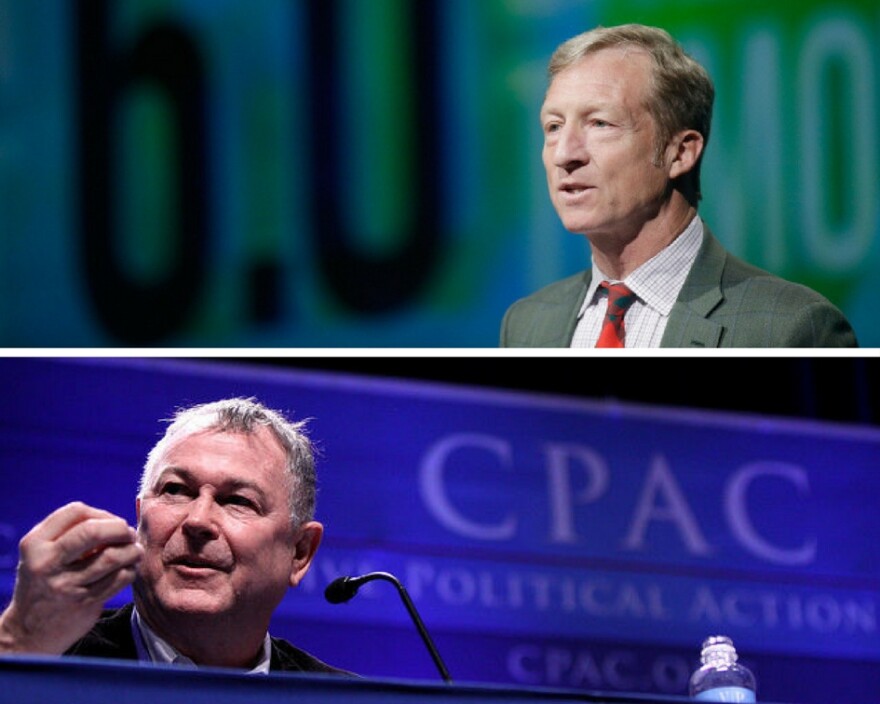With our free press under threat and federal funding for public media gone, your support matters more than ever. Help keep the LAist newsroom strong, become a monthly member or increase your support today.
KPCC reporters fact-check Rep. Dana Rohrabacher and Tom Steyer's climate claims

On June 1, KPCC produced a live on-air special on President Trump's decision to withdraw the United States from the Paris Climate Agreement. We interviewed U.S. Representative Dana Rohrabacher, R-Orange County, and investor and environmental philanthropist Tom Steyer about their views on the decision. Afterwards, we received many comments from listeners who felt we did not sufficiently challenge their claims. KPCC environment reporter Emily Guerin and correspondent Matt Bloom have this fact-check.
Rep. Dana Rohrabacher I have no doubt that there are these climate cycles and we go through them and it's only been until recently that the politicians have tried to claim that we have to control people's behavior in order to control those climate cycles. And so I disagree with the theory that CO2, done by mankind, is a major cause for climate change.
KPCC Ninety-seven percent of scientists are in agreement that human activities are responsible for global warming trends over the past 100 years. Most of the leading scientific organizations in the world have made public statements in support of this consensus, including the American Association for the Advancement of Science, the American Geophysical Union and the National Academy of Sciences.
The notion that the Paris climate agreement will “cause” anything is misleading, because the agreement is voluntary. Each country pledges to cut its emissions by a certain amount by a certain year. Every five years, each country reviews where it’s at and explains why it has or has not hit its targets. But the targets are not legally enforceable. Vox has a great explainer on this topic.
KPCC cannot find any evidence that the Paris accord mentions ending frequent flyer miles.
According to the Intergovernmental Panel on Climate Change, the body of international scientists that regularly scrutinizes climate research, “Human influence on the climate system is clear, and recent anthropogenic emissions of greenhouse gases are the highest in history. Recent climate changes have had widespread impacts on human and natural systems.”
According to the IPCC, sea level rose seven inches between 1901 and 2010. Not only is the sea level rising, but it’s rising faster than at any time over the past two thousand years. And the rate is only expected to increase in the future.
KPCC Steyer lumps all fossil fuels together here, but it’s a bit more complicated than that. Coal production is in decline, in part due to the lower costs of natural gas generation and growing market share of wind and solar power, according to the U.S. Energy Information Administration. Last year, the EIA said natural gas provided 33 percent of U.S. energy generation while coal’s share fell to 32 percent, making 2016 the first year that natural gas-fired generation exceeded coal generation on an annual basis.
Meantime, EIA says production of both natural gas and oil in the U.S. is booming. Since 2012, the U.S. has pumped more oil and gas than any other country in the world.
When Steyer says "storage," he means the ability to store the electricity produced by solar or wind generation in massive batteries so that the energy is available later, when the wind is no longer blowing or it's cloudy.
The REN21 Renewables Global Futures Report from the United Nations says that renewables are now the least expensive option for new power generation in almost all countries. But the limitations of existing infrastructure are a barrier to further expansion.
A lot of federal research and development grants jump start businesses here in Southern California. For example, the Department of Energy’s Advance Research Projects Agency-Energy, also known as ARPA-E, gave $2 million to Marine BioEnergy Inc. in La Cañada to develop a system for turning kelp into fuel. Other federally funded programs include $1 million for UCLA’s effort to build a better battery for electric vehicles. The Trump administration has signaled that it wants to eliminate ARPA-E funding next year.
A 2017 report from the U.S. Department of Energy found that California was home to 40 percent of the country's solar energy jobs, a number that could rise as the state moves toward ambitious renewable energy goals. Since 2004, greenhouse gas emissions in California declined over nine percent while the state's GDP grew 28 percent, according to the California Air Resources Board.







